 This past February, This One Summer (First Second, 2014) by Jillian Tamaki and Mariko Tamaki rocked the publishing, library, and literary world by being the first graphic novel to receive the Caldecott Honor for “Most Distinguished American Picture Book for Children” and
the Printz Honor for “Excellence in Literature for Young Adults.” It
has also been the subject of book challenges since receiving these
honors. In this post, we examine This One Summer’s merits,
issues of concern, and teaching elements to empower educators, parents,
and librarians to make their own decisions (for ages 12+).
This past February, This One Summer (First Second, 2014) by Jillian Tamaki and Mariko Tamaki rocked the publishing, library, and literary world by being the first graphic novel to receive the Caldecott Honor for “Most Distinguished American Picture Book for Children” and
the Printz Honor for “Excellence in Literature for Young Adults.” It
has also been the subject of book challenges since receiving these
honors. In this post, we examine This One Summer’s merits,
issues of concern, and teaching elements to empower educators, parents,
and librarians to make their own decisions (for ages 12+).Here's a bit about the book:
OVERVIEW
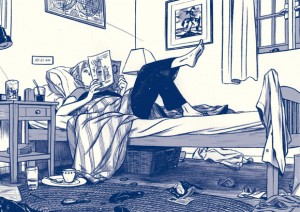 |
| This One Summer by Mariko and Jillian Tamaki |
In This One Summer, the art is as powerful as the prose and they work brilliantly together, delicately weaving the troubles and traumas of Rose’s summer at Awago Beach. The beach’s bright summer days are mixed with endless wet heavy rain, both helping to sustain the luscious trees, vines, bushes, grass, milkweed, and verdant undergrowth of the surrounding woods. Then, there are illuminating summer night skies full of stars and striking moonlight. The details of the beach, the lake, the woods, and even Brewster’s convenience store are breathtaking and contrasted by the less-detailed characters. The story and art are richly relayed and juxtaposed, giving extraordinary depth and presence to the story and its true-to-life characters.
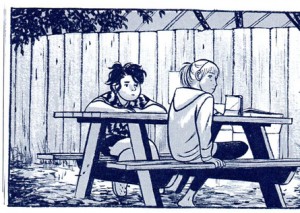 |
| This One Summer by Mariko and Jillian Tamaki |
For example, Rose and Windy are often seen swimming, diving, splashing in the water, and readers wonder if they are literally and figuratively out of their depth. Alice, Rose’s mom, and Dunc, the store clerk Rose develops a crush on, are both drawn with strong angles reflecting their short straight hair (that they run their fingers through in exhausted exasperation) and lanky, wiry physiques. They also both wrestle with unwanted aspects of pregnancies. While Dunc refuses to acknowledge Jenny and his role/responsibility for her pregnancy, Alice wrestles with facing her infertility and miscarriage.
Themes embraced and delicately tackled in This One Summer include:
- The tugs of friendship as Rose and Windy (a year and a half younger than Rose), face adolescence at different paces and stages;
- The pains and torments of depression felt by individuals and their families;
- The importance and frailties of communication;
- The challenges of dealing with unwanted pregnancies and failing at wanted ones;
- The stresses and responsibilities of teen sexuality and group pressure.
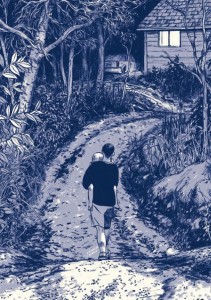 |
| This One Summer byMariko and Jillian Tamaki |
In This One Summer, Mariko Tamaki’s prose and Jillian Tamaki’s lush art invite us to watch and learn about real life issues in a sensitive and hopeful manner. We meet tweens fantasizing about what their developing breasts will look like. We learn how one family deals with the mother’s growing depression. We watch along with Rose and Windy as we observe, overhear, and deal with older teens. We see how long, comfortable summer friendship is stressed and strained by a one-and-a-half-year age gap between the girls as they enter adolescence. And finally, we observe (along with Rose and Windy) how older teens and adults deal with their own relationships and sexuality.
Jillian Tamaki’s monochromatic blue images and the wide range of textures and details in the artwork add incredible depth, passion, and complexity to Mariko Tamaki’s prose. This One Summer is truly a feast for mind and eyes. The beauty, power, and serenity of the beach, the expansive night skies, the milkweed plants and pollen, and the woods of Awago Beach balance the secrets, sorrows, and unfolding drama of the characters. What makes this book so outstanding is the sensitive manner in which important real life issues and challenges are faced honestly and imperfectly by the very real characters of Awago Beach. The out-of-depth feelings the characters experience are beautifully offset by the power of the water and the beach. As their secrets unfold, all but the tweens are reluctant to talk about them. As a result, this book can be a powerful resource and jumping point for healthy, open, non-threatening discussion about powerfully challenging life issues.
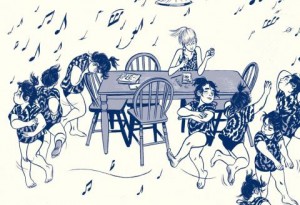 |
| This One Summer by Mariko and Jillian Tamaki |
Elements of Concern
This One Summer earned a Caldecott Honor, which covers children’s book for readers up to age 14, putting the book at the high end of the age spectrum for the honor. First Second recommends this book for ages 12 and up because it contains mature content. Despite having rightfully received this honor, there may be some confusion by consumers unfamiliar with this book and who believe the Caldecott honor is given exclusively to books for younger readers. To clarify, please note that there is some profanity, especially dealing with the older teen characters (the girls are labeled “sluts”). There is also a teen pregnancy and the burgeoning questions of sex and sexuality that the tweens experience in parallel subplots.
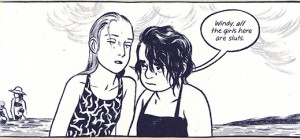 |
| This One Summer by Mariko and Jillian Tamaki |
For classroom lessons or book club lesson suggestions, please see my post "Using Graphic Novels in Education: This One Summer" - a featured column I write for The Comic Book Legal Defense Fund
***
In the meantime, below is an excerpt from an interview I did with Mariko Tamaki and Jillian Tamaki right after hearing they received the Caldecott and Printz Honors. [For the full interview, please visit my post "CBLDF Talks with Caldecott and Printz Honor Winners Jillian Tamaki and Mariko Tamaki"
This One Summer has taken the children’s books and graphic novel communities by storm, being the first graphic novel to win the Caldecott Honor for “Most Distinguished American Picture Book for Children” and Printz Honor for “Excellence in Literature for Young Adults.” It is a coming-of-age story that embraces readers of all ages as two tween girls, some local townie teens, and one set of parents all look at growing up, pregnancy, and babies from very different perspectives. What makes this book so special is how it sensitively and somewhat magically deals with these very difficult and mature issues through the growing awareness of two girls one summer. CBLDF is thrilled for the recognition graphic novels are beginning to get outside the comic book communities (hoping this will be just the beginning), we are thrilled for the recognition this gem of a book has received for its breathtaking prose and art, and we are thrilled to have had the opportunity to talk with Jillian Tamaki and Mariko Tamaki just after receiving these honors.
This One Summer by Mariko and Jillian Tamaki
CBLDF: First, we’d like to thank you for taking the time to talk with us. We know you’ve been getting tons of interview requests and appreciate the time and consideration you’ve given us.
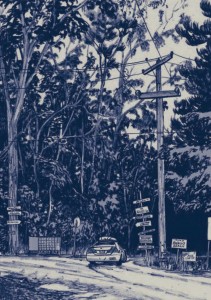 |
| This One Summer by Mariko and Jillian Tamaki |
Jillian Tamaki: What more is there to say except for it’s really, really cool? I never expected to win the Caldecott, given it is not a picture book.
Mariko Tamaki: It was an honor to be honored.
CBLDF: What were your later thoughts about winning these prestigious honors?
Mariko Tamaki: Wow, I must be prestigious now. Better get back to work.
Jillian Tamaki: It’s only been a few days!
CBLDF: Mariko, you’ve written both graphic novels and prose. What made you decide this story was a graphic novel? (Jillian, feel free to jump in here too).
Mariko Tamaki: I think in this case the setting felt really ripe for a comic. Also so much of this was about atmosphere. Not just the visual details but the little noises in the silence that Jillian captured so well.
CBLDF: You’re cousins, and some swear it’s best to keep work and family separate. How does your familial relationship affect the ways in which you work together?
Jillian Tamaki: Ehh, that’s usually good advice, probably. Oh well. I think we share a similar Tamaki humour. Very dry.
Mariko Tamaki: I think it makes it all the more important to make sure we don’t wear the same thing when we appear in public.
CBLDF: I loved This One Summer for so many reasons. What struck me while reading this was how many subtle layers there were in the prose, art and story lines and yet how exquisitely seamlessly it unfolds. It’s a thoughtful, sensitive journey exploring love, relationships, life and growing up, but feels as light and warming as the magical milkweed pods that float up and around the beach on pages 32-33. The dialogue, the characters, and situations in this book ring so true and personal. Were they taken from your own lives, were you channeling you or your friends at Rose and Windy’s age, or is this story purely fictional?
Jillian Tamaki: I don’t think anything is purely fictional or purely autobiographical. You’re constantly weaving in elements of your life and personal philosophy in ways that are conscious and subconscious.
Mariko Tamaki: Exactly.
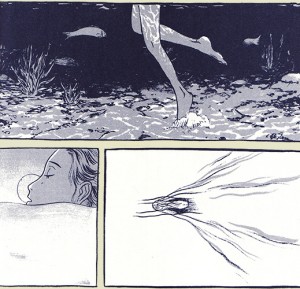 |
| This One Summer by Mariko and Jillian Tamaki |
CBLDF: There are so many stories going on here between tweens Rose and Windy, the mystery around Rose’s parents’ marital issues, and even around the local teen scene. In short, this coming of age story for tweens has mature topics and some mature language, especially with Dunc the Corner Store Guy and his friends. Was there an editing process around the book, story and its rating?
Jillian Tamaki: Sure. There was some discussion about the sex terms. But, to be honest, that’s not something Mariko and I consider too much. We’ve been lucky in that we’ve been able to make the books we want to make and reflect what we believe to be a true experience.
Mariko Tamaki: I think half the fun of this is remembering the ways we talked about stuff when we were little. Which were probably FAR TAMER than the way kids talk about things today.
CBLDF: As a follow-up, have you received any challenges for this book from tween or younger reader communities?
Mariko Tamaki: I believe the book was removed from one shelf in New Jersey, but the decision, thanks to an amazing librarian’s fighting the good fight, was reversed. Beyond that I tell people that the book addresses the existence of sex, when they ask if there’s anything inappropriate in it. I follow that up by saying that I, myself, do not think that is inappropriate.
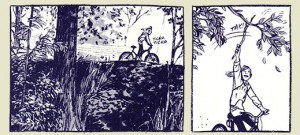 |
| This One Summer by Mariko and Jillian Tamaki |
Jillian Tamaki: I feel like a lot of those distinctions are marketing decisions. I try to make books that appeal to myself and maybe a few ideal readers. I love that people of different ages can take various things away from the story, though.
CBLDF: Thank you so much for your time and awesome responses. We are thrilled for you and we’re thrilled for the industry. We’ll definitely be looking out for your next projects.
 |
| This One Summer by Mariko and Jillian Tamaki |
For extended reading here are some Paired Reading Suggestions:
- I Kill Giants by Joe Kelly and JM Ken Niimura: About an 11-year-old girl who struggles to face and understand an untimely loss, first through escapism and then gradually through acceptance.
- Chiggers by Hope Larson: About growing up, friendships, funs and foils of summer camp.
- Are You There God? It’s Me, Margaret by Judy Blume: About the trials and tribulations of growing up, particularly for adolescent girls.
- Chinese Born American by Gene Luen Yang: Another Caldecott Honor winner about a teenager’s need to fit in.
- Before You Go by James Preller: About Jude, who takes a summer job flipping burgers at Jones Beach while dealing with his mother who is kept in a darkened room ever since his little sister drowned several years before.
- The Color of Earth Trilogy by Kim Dong Hwa: Like This One Summer, the Color of Earth Trilogy is a beautifully balanced blend of prose, poetry, and art that tactfully and sensitively deals with a girl’s growth from adolescence to adulthood.
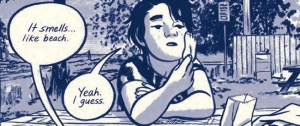 |
| This One Summer by Mariko and Jillian Tamaki |
- Preview This One Summer here: http://us.macmillan.com/thisonesummer/jilliantamaki
- stayteen.org: Information for teens on teen pregnancy, birth control, building relationships, the low down on sexually transmitted infections, myths and more.
- Teen pregnancy prevention tips and resources: http://www.cdc.gov/teenpregnancy/
- For information about teen depression:
- A site meant and written for teens on depression, discussing why people get depressed, how to cope with and fight depression and more: http://kidshealth.org/teen/your_mind/mental_health/depression.html
- On what teen depression feels like, how to talk to friends and parents, and more: http://www.helpguide.org/articles/depression/teenagers-guide-to-depression.htm
- For information about parental depression, please visit
- http://www.childtrends.org/?indicators=parental-depression
- From the Centre for Addiction and Mental Health, Canada, a site that discusses “When a parent is depressed…. What kids want to know”: http://www.camh.ca/en/hospital/health_information/for_children_youth/Pages/when_parent_depressed.aspx
- Six Things Every Kid should Know About a Parent’s Depression from PBS: http://www.pbs.org/thisemotionallife/blogs/6-things-every-kid-should-know-about-parents-depression
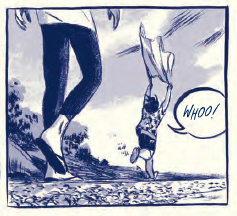 |
| This One Summer by Mariko and Jillian Tamaki |
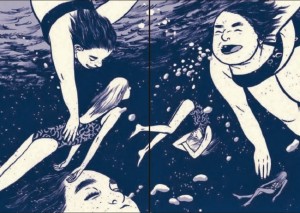
Awww sounds like a nice book and I love the illustration. This made me miss my graphic novels at home. I wish I can borrow this in my local library!
ReplyDeleteI imagine this book in that form would draw even pre-teens to it. As a retired teacher who taught 5th & 6th graders for awhile, would interest boys in reading it. Certainly it's a topic that needs to be addressed. I like the interview of Jillian and Mariko.
ReplyDeleteAwesome work, such interesting text too!
ReplyDeleteBest wishes,
Di.
ABCW team.
You're back! Yay.
ReplyDeleteLooks like my daughter's room...
ROG, ABCW
I like the contrast between the very detailed illustrations and those that are pared down.
ReplyDeletehttps://saglamproxy.com
ReplyDeletemetin2 proxy
proxy satın al
knight online proxy
mobil proxy satın al
X3K